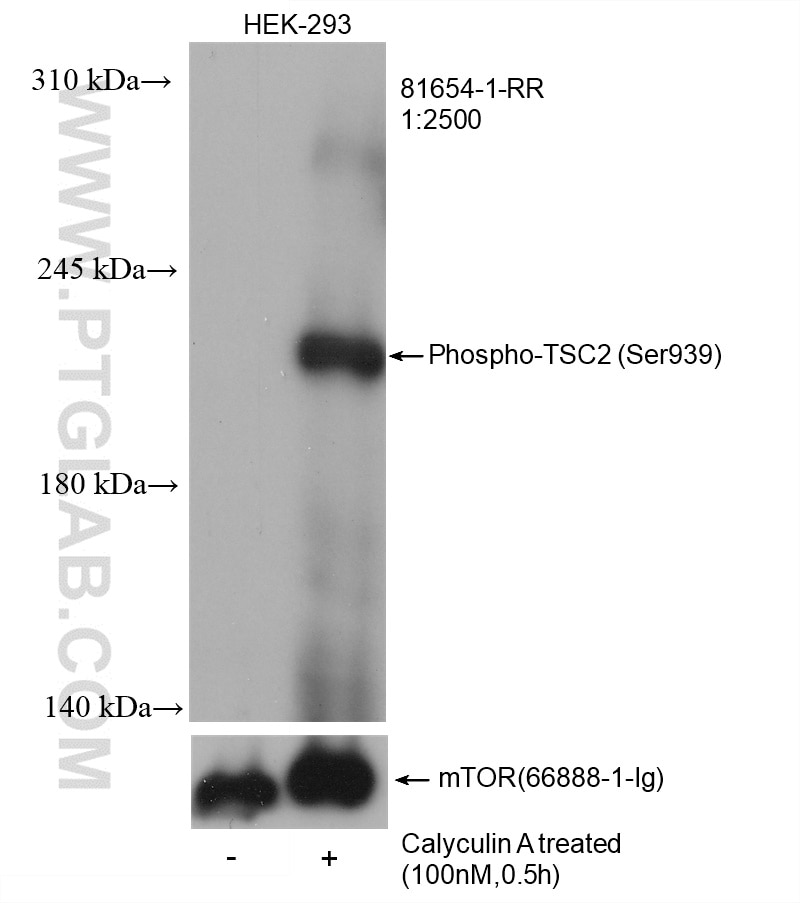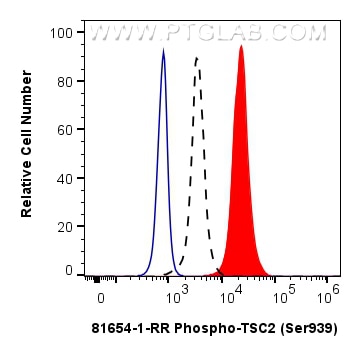Tested Applications
| Positive WB detected in | Calyculin A treated HEK-293 cells |
| Positive FC (Intra) detected in | Calyculin A treated HEK-293 cells |
Recommended dilution
| Application | Dilution |
|---|---|
| Western Blot (WB) | WB : 1:1000-1:5000 |
| Flow Cytometry (FC) (INTRA) | FC (INTRA) : 0.06 ug per 10^6 cells in a 100 µl suspension |
| It is recommended that this reagent should be titrated in each testing system to obtain optimal results. | |
| Sample-dependent, Check data in validation data gallery. | |
Product Information
81654-1-RR targets Phospho-TSC2 (Ser939) in WB, FC (Intra), ELISA applications and shows reactivity with human samples.
| Tested Reactivity | human |
| Host / Isotype | Rabbit / IgG |
| Class | Recombinant |
| Type | Antibody |
| Immunogen | Peptide Predict reactive species |
| Full Name | tuberous sclerosis 2 |
| Calculated Molecular Weight | 1807 aa, 201 kDa |
| Observed Molecular Weight | 200 kDa |
| GenBank Accession Number | BC150300 |
| Gene Symbol | TSC2 |
| Gene ID (NCBI) | 7249 |
| RRID | AB_3085356 |
| Conjugate | Unconjugated |
| Form | Liquid |
| Purification Method | Protein A purification |
| UNIPROT ID | P49815 |
| Storage Buffer | PBS with 0.02% sodium azide and 50% glycerol , pH 7.3 |
| Storage Conditions | Store at -20°C. Stable for one year after shipment. Aliquoting is unnecessary for -20oC storage. 20ul sizes contain 0.1% BSA. |
Background Information
TSC2, also named Tuberin, plays an essential role in the cellular energy response pathway. TSC2 forms a physical and functional complex with TSC1 that can inhibit the nutrient-mediated or growth factor-stimulated phosphorylation of S6K1 and EIF4EBP1 by negatively regulating mTORC1 signaling. Tuberin is phosphorylated on Ser939 and Thr1462 in response to PI3K activation and the human TSC complex is a direct biochemical target of the PI3K/Akt pathway (PMID: 12150915).
Protocols
| Product Specific Protocols | |
|---|---|
| WB protocol for Phospho-TSC2 (Ser939) antibody 81654-1-RR | Download protocol |
| Standard Protocols | |
|---|---|
| Click here to view our Standard Protocols |





